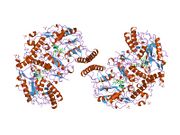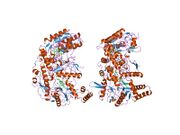Biology:Nitric oxide synthase 2 (inducible)
 Generic protein structure example |
Nitric oxide synthase, inducible is an enzyme which is encoded by the NOS2 gene in humans and mice.[1]
Genetics
Three related pseudogenes are located within the Smith-Magenis syndrome region on chromosome 17. Alternative splicing of this gene results in two transcript variants encoding different isoforms.[2]
Location
Nitric oxide synthase is expressed in epithelial cells of the liver, lung and bone marrow. It is inducible by a combination of lipopolysaccharide and certain cytokines.[citation needed]
Function
Nitric oxide is a reactive free radical mediating in neurotransmission, antimicrobial and antitumoral activities.[citation needed] In mice, the function of Nos2 in immunity against a number of viruses, bacteria, fungi, and parasites has been well characterized, whereas in humans the role of NOS2 has remained elusive and controversial.[3] Nos2 is important for protective immunity against CMV.[4]
Caveolin 1 has been shown to interact with Nitric oxide synthase 2A.[5] and Rac2.[6]
Deficiency
Autosomal recessive NOS2 deficiency has been described in mice. They lack the gene encoding nitric oxide synthase 2 (Nos2) and are susceptible to murine CMV infection.[7]
In February 2020, the same autosomal recessive, complete NOS2 deficiency was described in a human. A 51-year-old previously healthy person died after 29 months of progressive CMV infection due to respiratory failure secondary to CMV pneumonitis, CMV encephalitis, and hemophagocytic lymphohistiocytosis. Whole-exome sequencing on genomic DNA from his blood showed he had homozygous variants in five genes. The only loss-of-function variant was a homozygous frameshift mutation in nitric oxide synthase 2. This condition is extremely rare, occurring in fewer than 1 per million persons.[4]
References
- ↑ "Molecular cloning and expression of inducible nitric oxide synthase from human hepatocytes". Proc Natl Acad Sci USA 90 (8): 3491–5. May 1993. doi:10.1073/pnas.90.8.3491. PMID 7682706. Bibcode: 1993PNAS...90.3491G.
- ↑ "Entrez Gene: NOS2A nitric oxide synthase 2A (inducible, hepatocytes)". https://www.ncbi.nlm.nih.gov/sites/entrez?Db=gene&Cmd=ShowDetailView&TermToSearch=4843.
- ↑ Nathan, C. (2006-06-30). "Role of iNOS in Human Host Defense" (in en). Science 312 (5782): 1874b–1875b. doi:10.1126/science.312.5782.1874b. ISSN 0036-8075. PMID 16809512. https://www.science.org/cgi/doi/10.1126/science.312.5782.1874b.
- ↑ 4.0 4.1 Drutman, Scott B.; Mansouri, Davood; Mahdaviani, Seyed Alireza; Neehus, Anna-Lena; Hum, David; Bryk, Ruslana; Hernandez, Nicholas; Belkaya, Serkan et al. (2020-01-30). "Fatal Cytomegalovirus Infection in an Adult with Inherited NOS2 Deficiency" (in en). New England Journal of Medicine 382 (5): 437–445. doi:10.1056/NEJMoa1910640. ISSN 0028-4793. PMID 31995689.
- ↑ "Caveolin-1 down-regulates inducible nitric oxide synthase via the proteasome pathway in human colon carcinoma cells". Proc. Natl. Acad. Sci. U.S.A. 97 (26): 14334–9. December 2000. doi:10.1073/pnas.250406797. PMID 11114180. Bibcode: 2000PNAS...9714334F.
- ↑ "Specific association of nitric oxide synthase-2 with Rac isoforms in activated murine macrophages". Am. J. Physiol. Renal Physiol. 281 (2): F326–36. August 2001. doi:10.1152/ajprenal.2001.281.2.F326. PMID 11457725.
- ↑ Noda, Satoshi; Tanaka, Kazuo; Sawamura, Sada-aki; Sasaki, Masafumi; Matsumoto, Takako; Mikami, Katsunaka; Aiba, Yuji; Hasegawa, Hideaki et al. (2001-03-01). "Role of Nitric Oxide Synthase Type 2 in Acute Infection with Murine Cytomegalovirus" (in en). The Journal of Immunology 166 (5): 3533–3541. doi:10.4049/jimmunol.166.5.3533. ISSN 0022-1767. PMID 11207313.
 |




